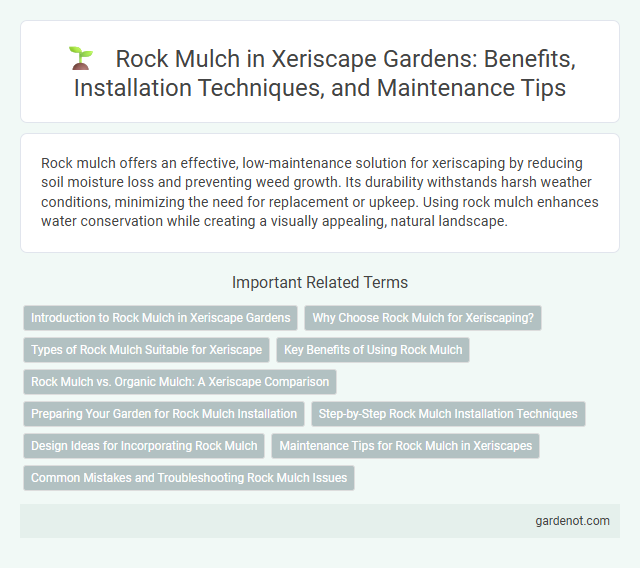Rock mulch offers an effective, low-maintenance solution for xeriscaping by reducing soil moisture loss and preventing weed growth. Its durability withstands harsh weather conditions, minimizing the need for replacement or upkeep. Using rock mulch enhances water conservation while creating a visually appealing, natural landscape.
Introduction to Rock Mulch in Xeriscape Gardens
Rock mulch in xeriscape gardens serves as an effective ground cover that conserves soil moisture and suppresses weed growth, essential for arid landscapes. Utilizing materials such as gravel, decomposed granite, or river rocks, rock mulch enhances drainage while reducing water evaporation from the soil surface. This low-maintenance alternative to organic mulch aligns with xeriscape principles, promoting sustainable water use and durability in drought-prone environments.
Why Choose Rock Mulch for Xeriscaping?
Rock mulch offers superior water conservation by minimizing evaporation and reducing soil moisture loss in xeriscaping. Its durability and low maintenance make it an ideal choice for arid climates where water efficiency is critical. The reflective properties of rock mulch also help regulate soil temperature, promoting healthier drought-tolerant plants.
Types of Rock Mulch Suitable for Xeriscape
Granite gravel, decomposed granite, and river rocks are ideal types of rock mulch for xeriscape gardens due to their durability and ability to retain moisture while allowing proper drainage. Lava rock is another popular choice, known for its lightweight properties and heat retention that benefits drought-tolerant plants. Crushed stone and pea gravel also serve as effective rock mulches, preventing soil erosion and reducing water evaporation in xeriscape landscapes.
Key Benefits of Using Rock Mulch
Rock mulch offers exceptional water conservation by reducing soil evaporation and minimizing irrigation needs, making it ideal for xeriscape gardens. Its durability prevents erosion and suppresses weed growth, reducing maintenance efforts and enhancing landscape longevity. Reflecting sunlight, rock mulch also moderates soil temperature, supporting healthy plant roots in arid environments.
Rock Mulch vs. Organic Mulch: A Xeriscape Comparison
Rock mulch provides superior moisture retention and erosion control compared to organic mulch in xeriscape gardens, making it ideal for arid climates. Unlike organic mulches, rock mulch does not decompose, reducing the need for frequent replacement and minimizing nutrient depletion in the soil. Its durability and reflective properties help regulate soil temperature, promoting healthier drought-tolerant plant growth.
Preparing Your Garden for Rock Mulch Installation
To prepare your garden for rock mulch installation, start by thoroughly clearing the area of weeds, debris, and any existing organic mulch to ensure a clean surface. Level the soil and consider laying a high-quality landscape fabric or weed barrier to prevent future weed growth while allowing water penetration. Proper soil preparation and barrier placement optimize drainage and stability, extending the life and appearance of your xeriscape rock mulch.
Step-by-Step Rock Mulch Installation Techniques
Rock mulch installation begins with clearing the area of weeds and debris to create a smooth, level surface. Next, a high-quality landscape fabric is laid down to prevent weed growth while allowing water permeability. Finally, distribute a 2-3 inch layer of decorative rocks evenly over the fabric, ensuring proper edging to maintain material placement and enhance the xeriscape's aesthetic and water conservation benefits.
Design Ideas for Incorporating Rock Mulch
Rock mulch enhances xeriscape design by providing natural texture and color contrast that conserves soil moisture and reduces erosion. Incorporate various sizes and shades of rocks around drought-tolerant plants, creating layered visual interest while promoting efficient water use. Edging pathways or garden beds with rock mulch adds definition and durability, complementing low-water landscapes with minimal maintenance.
Maintenance Tips for Rock Mulch in Xeriscapes
Rock mulch in xeriscapes requires minimal maintenance, focusing primarily on occasional debris removal and weed control to preserve its clean appearance. Periodically rinsing the rocks helps prevent dust buildup and maintains soil moisture by reducing evaporation. Inspecting the mulch layer annually ensures even coverage, which is crucial for effective water conservation and plant health in drought-prone landscapes.
Common Mistakes and Troubleshooting Rock Mulch Issues
Rock mulch often suffers from common mistakes such as improper installation depth and inadequate weed barrier placement, leading to ineffective moisture retention and weed growth. Troubleshooting involves removing excess mulch to allow soil aeration and reinforcing weed barriers to prevent unwanted plants from emerging. Monitoring soil moisture regularly ensures the rock mulch functions as intended in xeriscape environments.
Rock mulch Infographic

 gardenot.com
gardenot.com